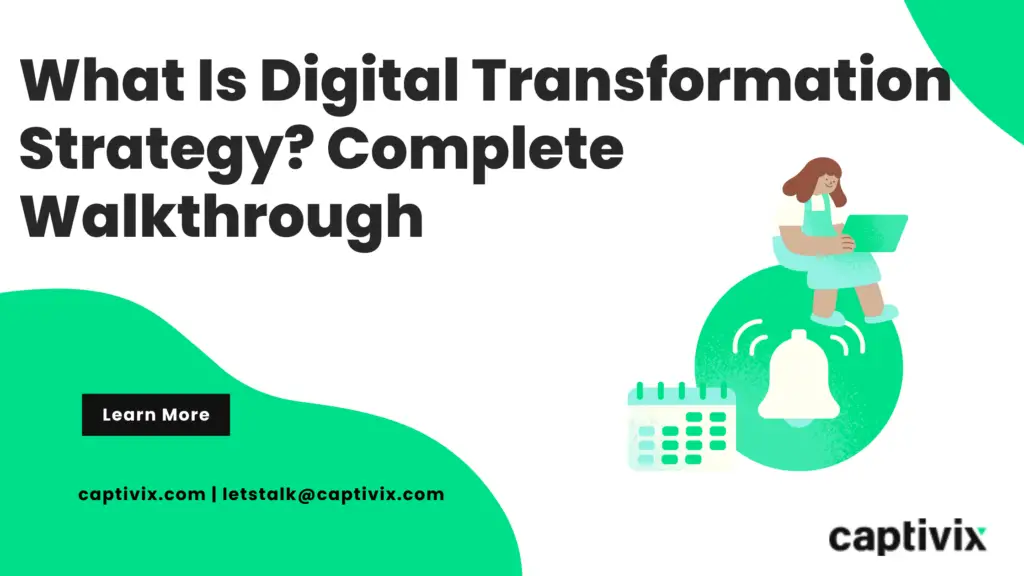Digital transformation strategy may be defined as the roadmap about how you will be making your business digital. It is used by companies to guide the way technology will be incorporated into their regular operations. Today, the practice of developing a good strategy is becoming the need of several companies because it makes their operations faster, and results in a more efficient version of themselves.
In this blog, we will tell you everything that you need to know about a good digital transformation strategy and how it can be developed.
What is a Digital Transformation Strategy?
Digital transformation strategy refers to the plan of action that organizations use to leverage technology to fundamentally change their operations, processes, products, and services. This helps you develop a better version of your company, making it more efficient and innovative. A good strategy enables one to embrace the opportunities presented by digital technologies and adapt to the changing needs and expectations of their customers.
What is a Digital Business?
A digital business is an organization that is innovative, flexible and efficient. It is a form of business that does not start from scratch but enhances the already present resources. The only thing that separates a digital business from a normal business is the ability of the former to strategize well.
Such businesses prioritize the demands of their customers and key stakeholders, and plan every step before investing in it. Another major aspect of such businesses is that they have active leadership, that guides the entire team quite well. This leader is not just any business leader but, a digital leader!
Benefits of Digital Transformation
A practical outlook for choosing anything new demands a better knowledge of its benefits. The same is true of digital transformation. We have listed out four benefits of digital transformation that will give you some clarity:
a. Betters efficiency and effectiveness: When you transform your business, it involves the implementation of technologies like AI, which enhances productivity and reduces errors. This also increases the general speed of working. In this way, the overall performance of your business becomes better and you are placed in a better position to compete with your competitors.
b. Improves engagement with stakeholders: Better processing of data helps you make smarter and quicker decisions. This in turn helps you predict the needs of the major stakeholders like your customers, employees as well as business partners. When you know what these people desire, you will be able to make improved decisions, which will have a positive outcome for your company.
c. Enhances activeness and responsiveness: With this transformation, the basic capabilities of your business are directed towards supporting change. This improves the responsiveness to the dynamic markets and makes the overall working more active. It is essential to respond to the changing demands of the market as well as the stakeholders, and most importantly, be active with it.
d. Ability to innovate: The process will also provide you with the ability to innovate through experiments and updated technology, with reduced chances of risk. You can experiment with newer ways of doing things and in the process, innovate newer techniques. This will result in better performance of the company.
Why is the Transformation Needed?
A lot of companies wonder why digital transformation is required. It is important to know the reason behind a particular phenomenon, in order to get started. Remember that digital transformation is not just any other project; rather it is the means to a speedier, more efficient and customer-centric you.
Digital transformation has become the need of the hour ever since technology hit the markets. Now, everyone wants to access all services from the comfort of their house, and if you cannot provide this to your customers, they are not liable to stay with you. This makes the process a much-needed one.
What Makes a Good Digital Transformation Strategy?
A good digital transformation strategy is quite the need of the hour, in this growing world of competition. It is essential to know what makes a good strategy, so that you can develop one by keeping those points in mind. There are three major components that any good strategy must focus on:
- Strategy
- Technology
- People
To be sure, you must have a clear set of goals as part of your strategy. These goals should be real and achievable, and not something that cannot be achieved even if you put in all your resources. Also, the technology that you use must cater to the needs of the customers and enhance their level of satisfaction. In the end, the customers are your priority.
Who Should Be Involved in Creating the Strategy?
This is a question that troubles a lot of people. Who should be involved in the team that creates a good digital transformation strategy? We have listed out the people who should definitely be part of your team for a successful strategy:
a. A communications specialist
Communication is a very crucial part of any project. A team that communicates well, performs well. This is where a communications expert helps you out. Digital transformation involves two groups of stakeholders, internal and external. The internal set of stakeholders is your employees. This group is very hard to convince about the efficiency of the new technology.
Generally, new technology brings with it the fear of being replaced in the minds of the employees. However, a communications specialist will help you out with this problem by interacting with the employees. This person is like a friend, who empathizes with another
b. An experienced technologist
The job of a technologist is quite intrinsic to digital transformation. It is this group that will manage the most important aspect: new technology. Therefore, it becomes crucial to hire an experienced technologist. For this purpose, you must begin by changing your thought process.
You must allow experimentation and let the technologist innovate through it. Do not bicker about how many times they made an error; rather let them work their way out. When you incorporate a changed mindset into your digital transformation strategy, your overall performance is bound to improve.
c. A good leader
A good leader is responsible for leading the entire project, with utmost efficacy. They will develop a strategy that is driven by data such that each step is analyzed based on facts. Also, a good leader knows how to sail through with an effective team. This is the major reason why you should find yourself a digital leader, based on experience and not seniority!
7 Steps to Build a Digital Transformation Strategy
A digital transformation strategy can only become successful when you build it through a set of clearly-defined steps. Many companies are confused about these steps and how they can go about the entire process. Therefore, we have listed 7 key steps to build a digital transformation strategy that works as per the needs of your business.
I. Understand the need for digital transformation
The first step to building a good digital transformation strategy is, to begin with, an understanding of the need for such a process. Ask yourself why you need to transform yourself. Jot down the needs and goals of your company, and once you know what you want, start working on the strategy.
It is advised that you begin by laying down a plan for the near future of the company. Formulate a business case and then, work as per the needs and goals of the plan. You will also require C-suite support, which is essential for cultural change.
II. Get ready for cultural change
Digital transformation strategy also brings about a cultural change in the entire organization. Most companies employ C-suite support for this process. To be sure, a lot of people will be resistant to change because of their fears of being replaced or being overburdened with work. However, it is on you to help them understand the reality.
As a leader, you need to inculcate confidence in the team. You can also develop a positive mindset and address issues that the employees might be facing. View it as a necessary step, that is going to improve your business in the longer run.
III. Be strategic in your approach
It is important to understand that your digital transformation strategy does not always have to be very grand. Remember that it is okay to have a small plan, as long as it is strategic. Digital transformation will take time and you do not have to hurry with the project. Be patient!
IV. Draft a roadmap for technology implementation
Technology is an essential part of digital transformation and therefore, you need a plan of action to implement it. The formula for digital transformation being driven by unsuccessful technology, as Leeder has put forth is: New Technology + Old Operations = Expensive Old Operations
It is wise to understand that a successful transformation is not based on technology but on a good digital transformation strategy. However, you need to focus on technology as well, so that it caters to the needs of your key stakeholders. You may refer to the following DX technologies that are essential for the process:
- Mobile
- Internet of Things
- Digital Twins
- Robotics
- Cloud
- Artificial Intelligence & Machine Learning
- Augmented Reality
- Additive Manufacturing
V. Find partners and seek expertise
When you start looking for a partner, you need to be very sure. Ask yourself important questions like, “Will the vendor help me out with scaling?” “Does the vendor have enough expertise in this industry?” It is crucial to have someone who knows how digital transformation strategies work.
Look for someone with the required expertise and technology, as there is no use in dealing with someone who cannot be trusted. The best way to ensure that your selected partner is a good one is through references. Ask other people in the industry, who are using the vendor’s services, about their level of support.
VI. Collect feedback
Before you start with your digital transformation strategy, you must define your key performance indicators (KPIs). After defining this, you need to gather feedback from your key stakeholders, like customers, managers, and employees. Try to understand what they seek from this process.
Ask them if your chosen route is helping them or not. Is it good enough for them? Remember that your customers are your priority and therefore, you need to try and do everything possible for their welfare. This will help you in the long run.
VII. Start the transformation
Once you have completed the above-mentioned steps, you can begin with the transformation. Be sure about everything that you do and always prioritize your key stakeholders. Remember that digital transformation will vary from company to company, making digital transformation strategy quite essential. This is your way of carrying out the process and so, you should work on it well.
8 Components of a Digital Transformation Strategy
When it comes to digital transformation strategy, there are 8 key components that you must involve. We have listed these components for your help and it is advised that you take all of them into account:
I. Strategy and leadership
A good strategy along with good leadership is crucial for digital transformation. These two define the success of your project. A good digital transformation strategy can be effective in ensuring better performance of the company, increasing customer satisfaction, and speeding up general functions.
Leadership is also an essential part of the process. A good leader, acts as a guiding light for the entire project. Therefore, you should find yourself an effective leader A good leader must have the given set of qualities:
- Agile in approach
- Ready for a change
- Advanced vision
- Take risks
- Keen on expanding partnership
II. Cultural change and communication
Remember that a digital transformation strategy is going to bring with it a cultural shift. You must be open to change and flexible in your approach. Prepare your employees for this change and help them understand the need for it. This can be achieved through better communication.
Try to have a clearer schedule for training your employees, keep them updated about the process and establish a work environment devoid of hesitation. Communicate whenever necessary!
III. Develop processes
Digital transformation involves several processes, which can make the entire functioning more efficient and speedier. Therefore, you must focus on business process optimization. The entire process must work for optimization of the entire process, while keeping customer satisfaction in mind. Try to make better use of all the data at your disposal for the optimum utilization of all your resources. This will give out positive results.
IV. Selecting Data
You must be aware that not all the data that your system comprises, is relevant. Therefore, you need to select all the data that is actually relevant to your company. It is only when you select the correct data that you will be able to understand the shortcomings of your business.
Data curation can help you understand the pain points of your business and then find solutions for the same. It helps you in getting better insights into the overall functioning of your company and places you in a more advantaged position, as compared to your competitors in the industry.
V. Technology
Technology is an intrinsic part of any digital transformation strategy. Therefore, it becomes important to select which technologies you will be requiring. A wiser choice would be to keep your budget, along with other important factors in mind. This component requires a lot of investment in terms of money as well. Certain technologies must be present in your digital transformation strategy:
- Cloud and distributed platforms: This is the future of the digital world, as predicted by Gartner. This technology provides you access to all your data from practically anywhere in the world.
- Data analytics and AI: Data is an intrinsic part of any project and here, it combines with the power of AI. This analyses data, and its optimum utilization possible.
- Digital experience and reality: With better technology, your digital experience is bound to increase. It is a step closer to a better you, through technology like IoT always at your disposal.
VI. Structure of the team
While technology and strategy are important in digital transformation, another equally crucial component is the team. It is this component which will be handling the process and abiding by the digital transformation strategy. Therefore, it becomes crucial to keep a well-defined structure of the team in mind. Your team must have the following set of members:
- Leaders, who will lead the project by acting as its guiding light and lead it to success. They will take charge of all the processes and ensure a smooth transformation with agility.
- Business champions, who will take all tasks into their hands. This group includes people like product managers, program managers and solution architects.
- Coders and designers, who will handle the development of the entire project at the most basic level. They will help you with coding and designing the best digital transformation.
VII. Partners
When you start looking for a partner, you can ask yourself important questions about their credentials. Find out if they have enough expertise in this field, to help you out. It is crucial to have someone who knows how digital transformation strategies work.
Look for someone with the required expertise and technology, as there is no use in dealing with someone who cannot be trusted. The best way to ensure that the vendor you are choosing is a good one, is through references. Ask other people in the industry, who are using the vendor’s services, about their level of support.
VIII. Results
Now it is time for results! Here, you will be assessing the success of your digital transformation. Remember that the result depends on how you worked on your digital transformation strategy, and how well you abided by it. Another decisive factor is the kind of technology you use.
Ensure that the team you are working with is flexible, has enough autonomy and is not resistant to change. Try to establish KPIs and find yourself a good digital leader. Agility is also another key to better results, so be active during the process.
Impact of Digital Transformation Strategy on Business
A major question related to digital transformation strategies is their impact on business. A lot of companies are worried about how the process will affect their business and therefore, we will address the same issues here.
a. What drives the digital transformation strategy?
The digital transformation of the world is a driver of any digital transformation strategy. The reality of the world is that technology is forever changing and therefore, it becomes crucial for companies to keep transforming to survive the competition. It is important to keep evolving and innovating to serve the demands of the key stakeholders, and outdo all competition.
b. Effects of not having a digital transformation strategy
To be sure, a strategy does not really have any effect on the overall performance of your business, because mere possession of a strategy does not mean that it is a good one. Remember that a digital transformation strategy may not always be effective, whereas not having a strategy in mind does not disrupt your business.
However, there are some key areas like technology, finance and healthcare which need a good strategy to get going. If your company deals with any of these, you should develop a good strategy for yourself, to have positive results.
c. Effects of having a digital transformation strategy
Now that you know the effects of not having a digital transformation strategy, you must be wondering about the effects of having one. We will help you out with it. Having a digital transformation strategy has a lot of benefits for the business that uses it. They are as follows:
- Assess the overall performance and value.
- Connect your digital strategy to a roadmap.
- Get better at the confluence of products and technology.
- Innovate and create newer products and services.
- Quicken resource allocation.
- Improve time-to-market and reduce time.
- Elevate organizational activeness.
d. How can I measure ROI on digital transformation?
A lot of companies want to know if their return on investment is actually profitable or not, and therefore they want to know how to measure it. It is practically easy to measure your ROI on digital transformation. We will tell you can do it by following the given set of practices:
- Set initial metrics beforehand, even if imaginary.
- Develop “micro-metrics” for experimenting with Agile.
- Involve business outcomes.
- Look at strategic and operational impact.
- Keep reviewing metrics to improve and adapt.
Types of Digital Transformation Strategies
A digital transformation strategy plays an important role in the entire process, as it acts as a roadmap for you. However, a lot of companies get confused about the type of strategy they should employ. We have listed three main types of digital transformation strategies that will help you choose the best one:
I. Business Transformation Strategy
Since transformation is becoming a reality these days, businesses are also becoming keen on transforming themselves quickly. They aim at being up-to-date with whatever is new in the market and therefore, they opt for a business transformation strategy. To be sure, technology is now a part of our lives.
Whether it is about shopping for your new dress or booking flight tickets or even getting a manicure, technology is everywhere. Therefore, as a business, you can take up this strategy and experience the positive changes yourself.
II. Technology Transformation Strategy
Another digital transformation strategy is related to technology, which is becoming a decisive factor in the business industry. It has become a fact that your position in the market depends on how well-equipped you are with the latest technology. Businesses are becoming more focused on how they can implement the best technology at their disposal. It is, therefore, wise to invest in this strategy to cater to the needs of your key stakeholders.
III. People Transformation Strategy
Today, human resource is one of the most valuable and dynamic resources available in the industry. It is therefore considered wise to deploy a people transformation strategy, to utilize their capacity well. Key features of this strategy include working on the growth of your entire team, encouraging an innovation culture at your company and giving your employees enough elbow room to exercise autonomy.
Effects of Not Having a Digital Transformation Strategy?
Many businesses consider the importance of having a digital transformation strategy to be hype. This is why they do not concern themselves with it. To be sure, a strategy does not really have any effect on the overall performance of your business, because mere possession of a strategy does not mean that it is a good one.
Remember that a strategy may not always be effective, whereas not having a strategy in mind does not disrupt your business. But businesses which have a poor strategy face consequences due to unclear thoughts and plans. In a nutshell, strategy is important but it does not guarantee success.
Is My Strategy Working?
A lot of businesses want to know if their strategy is working or not. It can be difficult to measure this part but, not so much when you have us by your side. Let us keep it simple. To understand if your digital transformation strategy is working, you need to know what you wanted it to achieve initially.
It is only when you know your expectations, that you will be able to assess your strategy’s success. So, it is advised that you first understand where you wanted to reach. If you have reached that point, your strategy is working!
5 Key Trends for Digital Transformation
Digital transformation is slowly becoming the talk of the town because of its many benefits. The industry is witnessing several trends in this sphere, five of which have been discussed below:
I. Faster investment
A lot of companies are increasingly digitizing their functions, ever since the pandemic hit us. These functions have been made digital for three to four years. Moreover, they are also becoming more and more digital day by day. This means that companies are investing their time and money in digital transformation at a faster pace!
II. Digital plus workforce transformation
Accenture conducted a study named Future of Work Study in 2021, in which it concluded that as many as 83% of workers prefer a hybrid mode of working. A mix of flexible work environments along with scaling of Agile, is really helping companies witness the best version of themselves, in a short span of time.
III. AI and machine learning
Newer technology in the form of AI and machine learning is making the everyday operations of companies easier. It is also facilitating digital transformation, making it a speedier process. Now the collection and storage of data are becoming easier and it is all thanks to AI. Moreover, machine learning is also making training a less hectic task.
IV. Use of data and analytics
Digital transformation is helping companies use advanced data, which is further helping them in predicting the future of the company. The increasing use of data and analytics is another sign of the full transformation of your business into a digital one, which is faster and better.
V. Automation
Automation in digital transformation is helping companies respond to customer demands and increase their level of satisfaction. It also enhances the performance of employees and gives positive results, making your company more efficient in whatever it does.
Takeaway
In this blog, we have tried to explain what a digital transformation strategy is, and how it can prove to be beneficial for your company. You may follow the given steps to ensure that you formulate a successful digital transformation strategy for your company. A good strategy must have the eight components discussed in this blog. If you follow them step-by-step, your strategy will bring out positive results for you!
Source link







Leave a Reply